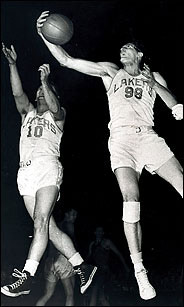 |
 |
 |
 News from Around the Americas | June 2005 News from Around the Americas | June 2005  
George Mikan, 80, Dominant Basketball Center, Dies
 Frank Litsky - NYTimes Frank Litsky - NYTimes


| | George Mikan grabbing a rebound while playing for the Minneapolis Lakers in 1949. (Photo: AP) |
George Mikan, the Minneapolis Lakers center who was the first superstar in modern professional basketball and a player so big and so dominant that college and pro rules were changed in an effort to handcuff him, died Wednesday at a rehabilitation center in Scottsdale, Ariz. He was 80.

At 6 feet 10 inches and 245 pounds, Mikan was never as naturally smooth as latter-day basketball superstars like Michael Jordan or Magic Johnson. He grew up self-conscious and self-doubting and he wore eyeglasses on the court, but through relentless hard work he became the pro game's paramount inside player from 1946 to 1956. He led his teams to seven league championships in nine years, including five National Basketball Association titles with the Lakers, teaming up with fellow Hall of Famers Jim Pollard and Vern Mikkelsen and guard Slater Martin.

Mikan's trademark was a sweeping hook shot with either hand. He was the N.B.A.'s scoring leader three times and finished with 11,764 career points during his two seasons in the National Basketball League and seven with the N.B.A. He averaged 22.6 points a game in an era of less-refined shooting and lower scores, and he was a rebounding power.

The Associated Press named Mikan the best basketball player of the first half of the 20th century. He was named to the N.B.A.'s 50th anniversary 50-man all-time team and the National Invitation Tournament's all-time team, for taking DePaul University of Chicago to the 1945 championship.

"He literally carried the league," Bob Cousy, the Boston Celtics' Hall of Famer and the N.B.A.'s pre-eminent guard in its early years, told The Associated Press yesterday. "He gave us recognition and acceptance when we were at the bottom of the totem pole in professional sports."

In 1959, Mikan became a member of the first group inducted into the Naismith Memorial Basketball Hall of Fame in Springfield, Mass.

Mikan sustained various injuries during his career including fractures of both legs, his left arch, right foot, nose, right wrist, thumb and three fingers, plus 166 stitches.

Through it all, he prevailed, even when rules were introduced to limit his effectiveness. At DePaul, he once recalled: "We would set up a zone defense with four men around the key and I guarded the basket. When the other team took a shot, I'd just tap it out."

To negate that, the National Collegiate Athletic Association banned goaltending in 1944.

In the N.B.A., when his team had the ball, Mikan set up one step from the basket. The league countered during the 1951-52 season by widening the lane under the basket, where an offensive player could stay for only three seconds at a time, to 12 feet from 6 feet. But Mikan scored 61 points in a game that season against the Rochester Royals.

In a November 1950 game, the Fort Wayne Pistons decided the only way they could beat Mikan and the Lakers was to hold onto the ball. They won, 19-18, the lowest-scoring game in N.B.A. history. In 1954, the N.B.A. introduced the present rule that required a team to shoot within 24 seconds of getting the ball.

George Lawrence Mikan was born June 18, 1924, in Joliet, Ill. At his high school graduation he was 6 foot 8. He used to stoop to make himself look shorter.

"I became round-shouldered, ungainly and so filled with bitterness that my height nearly wrecked my life," he once said. "Later, I found that a tall man didn't have to accept clumsiness."

While in high school, Mikan wanted to be a priest and for a time he studied in a Chicago seminary, leaving no time to play basketball. He did play during the summers on playgrounds and he wanted to go to Notre Dame, but the coach, George Keogan, rejected him for being clumsy.

Mikan found a home at DePaul, where Coach Ray Meyer tried to rectify his clumsiness with an intensive training regimen. He skipped rope, shadowboxed and ran. The routine helped, and he became an All-American three times and the college player of the year twice.

His first pro team was the 1946-47 Chicago American Gears of the N.B.L. After one season, he moved to the N.B.L.'s Lakers. One season after that, the Lakers and three other N.B.L. teams joined the new Basketball Association of America, which a year later became the N.B.A.

Mikan so captured the public's imagination that the N.B.A. often sent him on the road a day before a game to drum up publicity for his next game.

He was still in his prime when he retired at age 29 after the 1953-54 season, saying he wanted to spend more time with his family.

Two seasons later, he returned, but was only a shadow of himself. He then retired as a player for good. He became the Lakers' coach in 1957, started the season, then quit with a 9-30 record.

After basketball, he worked in Minneapolis as a corporate and real-estate lawyer. He bought and renovated buildings, owned a travel agency and ran for Congress as a Republican, losing in a close race.

He was the first commissioner of the American Basketball Association, from 1967 to 1969. He lived in the Minneapolis suburb of Edina, Minn., and in Scottsdale.

Mikan is survived by his wife, Patricia; his sons Larry, Terry, Patrick and Michael; and his daughters Trisha and Maureen, The Associated Press reported. His brother, Ed, who also played for DePaul and later in the N.B.A., died in 1999.

Of all the tributes paid to Mikan during his career, perhaps the grandest came from the marquee outside the old Madison Square Garden. It read:

WED BASKETBALL
GEO MIKAN v/s KNICKS | 
 | |
 |



